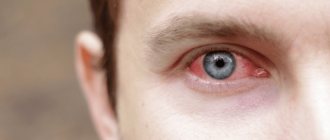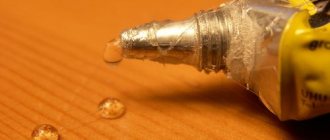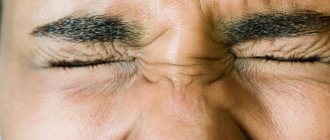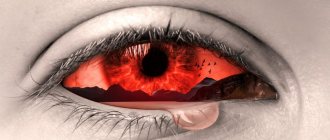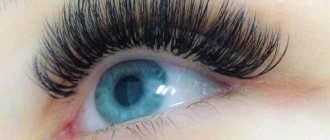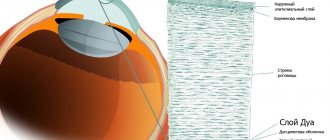Housewives usually store vinegar in their kitchen . And curious children can easily knock the bottle over themselves and get serious chemical burns.
It’s even worse if a drop of the substance gets into your eyes: it immediately causes a burn to the retina, which can lead to loss of vision .
Due to carelessness, an adult can also receive such an injury.
Keep in mind! One thing is clear: there is no time to reproach and shake your head, you need to urgently help the victim.
Symptoms
Symptoms of a chemical burn depend on the concentration of the substance.
If an accident occurs with acid up to 9%, which is most often used in everyday life, you can hope for a favorable outcome.
But 70% vinegar can completely melt the cornea and lead to the formation of a cataract, which cannot be treated.
If vinegar gets on the cornea, a person experiences:
- severe burning and pain;
- tearfulness;
- itching;
- dizziness.
These symptoms include blurred vision and redness of the eyes and eyelids.
What you should absolutely not do if you have a vinegar burn
Every person's first aid kit probably contains a variety of antiseptics and medications for treating wounds. The most popular include iodine, brilliant green, potassium permanganate, and hydrogen peroxide. It is strictly forbidden to treat wounds with vinegar burns with these solutions. Not only will they not produce results, but they may even make the situation worse.
Badger and bear fat have long been popular among adherents of alternative medicine. But treating wounds with fat is also prohibited. They create an invisible film. Under the dense layer, an ideal environment is formed for the development and reproduction of pathogenic microflora. After a few days of such self-medication, the wound may begin to fester.
It should be noted! A chemical burn is a fairly serious injury, the consequences of which are unpredictable. If even the slightest doubt arises, it is recommended to contact the trauma department at the nearest medical facility.
An adult is responsible for his body and health independently, but if we are talking about a child, it is better to spend a couple of hours consulting a specialist who will competently plan treatment.
First aid at home
You should know! A chemical burn to the eye cannot be cured on your own.
But first aid is necessary to reduce pain and prevent the substance from penetrating into the deep tissues of the eye.
For an adult
An adult needs to rinse the eyes for 15-20 minutes or until the burning sensation completely disappears .
To do this, you need to either place your open eye under running water, or fill a basin with cool water, lower your face there and blink quickly.
The colder the water, the stronger the analgesic effect.
Then you can do the same procedure, but pour a little soda into a bowl of water . The concentration should be 1 teaspoon of soda per 1 glass of water.
Note! If the burning sensation still does not disappear, it is recommended to repeat the procedure again and again, taking short breaks.
A cold compress is then applied to the eye . You can keep it until your appointment with the doctor.
To kid
The procedure for providing first aid to a child is practically no different from that for an adult.
just need to rinse your eyes with a syringe without a needle : pour cold water into it and rinse the eye, slightly pulling back the lower eyelid.
The child must be positioned in such a way that the water flows down, for example, over a basin or sink.
Do not wipe your eyes with a towel or allow your child to rub them with their hands.
Then the syringe is filled with a weak soda solution to wash the eyes.
The washing procedure can be repeated several times.
Remember! After this, you need to apply a sterile bandage and take the child to the emergency room as soon as possible.
Acetic acid burn on the skin: how to treat, first aid
Vinegar of varying concentrations is present in almost every kitchen. This solution must be used with extreme caution, as it is easy to burn yourself at home. Such an effect can be quite severe, so you must always remember what to do if you are burned by vinegar.
Most often, injury is caused by improper handling of fluid. Children of preschool age most often end up in the hospital; they may unknowingly douse themselves with vinegar or drink it.
Damage can be internal, affecting the mucous membrane, and external, when the epidermis is damaged. Injuries to the upper parts of the feet often occur when liquid droplets end up on the floor and legs while cooking.
So how to treat a vinegar burn, and how to speed up healing?
First aid
If vinegar gets on the surface of the skin, it is necessary to promptly provide emergency assistance to the victim.
- Soda solution to remove clothing that has come into contact with the chemical;
- Rinse the burn area thoroughly in running cool water. The duration of rinsing should be at least 15 minutes;
- treat damaged skin with any alkaline solution. The following are used as a vinegar neutralizer: soap solution, soda solution;
- rinse the damaged skin surface again with running water, the duration of the procedure is at least 10 minutes;
- Apply a damp one soaked in water to the wound and secure with a bandage. This procedure will help reduce the concentration of remaining acid;
- to prevent possible infection, it is recommended to additionally treat the wound surface of the skin with antiseptic ointment;
- if the burn represents serious damage, then the victim must call an emergency team.
Symptoms of damage to different parts of the body
The list of symptoms from the effects of vinegar on the body depends on the area of the skin that was injured, its area and the duration of contact with the acid. It happens that unpleasant signs do not appear immediately, but only after some time. This happens especially often when acid has spilled onto clothing that has been in contact with the skin for quite a long time.
Without proper and timely assistance, a vinegar burn can lead to the death of a person if a large area of the body is affected.
Esophagus
Injury to the esophagus occurs when a person swallows an aggressive substance. This is the most difficult situation and poses a danger to life. In these circumstances, immediate hospitalization of the victim is necessary. A lethal dose is considered to be 40 ml of 70% essence.
When this substance is ingested, the following symptoms develop:
- severe burning pain
- loss of voice,
- swelling of the mouth and esophagus,
- suffocation,
- pain shock,
- heart dysfunction,
- poor health, weakness,
- nausea, vomiting with blood,
- increase in body temperature.
The destructive effect of vinegar essence in the stomach is enhanced by the presence of hydrochloric acid in it. For severe injuries to the esophagus, surgical intervention is used.
Oral cavity
A burn of the oral mucosa with vinegar is expressed by the presence of the following symptoms:
- sharp pain
- decreased sensitivity of taste buds,
- severe swelling, making swallowing difficult,
- increase in body temperature,
- rapid deterioration in general health.
Degree of acetic acid burn
Vinegar is a carboxylic acid. It is colorless and has a pungent odor. If the concentration is low - sour taste. When it gets on the skin or mucous membrane, it destroys proteins and soft tissue cells. Necrosis, that is, cell death, occurs instantly.
The reaction is characterized by the release of water. The degree of chemical burn to tissue encountered by this caustic substance depends on the concentration. The most severe vinegar burn can be obtained from vinegar essence, the concentration of which exceeds 30%.
A weak solution will take some time. If acetic acid gets on clothing and the victim does not notice it immediately, the resulting burn can be severe. Every minute matters.
The nature of the damage depends on the amount and concentration of acetic acid ingested and the duration of contact with it.
There are different degrees of burns:
- First. Refers to mild lesions. It is characterized by superficial redness of the skin tissue, which may be accompanied by swelling and pain. In most cases it is treated quite quickly. After therapeutic actions there are no traces of burns left.
- Second. Along with the top cover, the germ layer of the epidermis is damaged. The formation of blisters on the skin is observed, which subsequently form a wound. Healing occurs over several weeks.
- Third. A deeper lesion, covering all layers of the skin. The wound consists of purulent discharge, clotted blood and dead cells. Requires long-term hospital treatment, the success of which depends on the first actions after the burn. Such injuries leave scars and scars.
- Fourth. The most dangerous form of pathology. Occurs upon contact with a strong acid solution. With such lesions, all skin cells die. The success of treatment depends on the size of the affected areas and the characteristics of the patient’s immune defense.
In the most severe cases, first aid and the timely arrival of an ambulance can save the victim’s life.
Treatment with folk remedies
After basic care has been provided and there is no threat to life and health, you can use traditional medicine recipes for further recovery. This therapy has a minimum of contraindications, but is not always more effective than pharmaceutical drugs. But the advantage of such therapy is its accessibility.
Recipe examples:
- Mashed raw potatoes. This remedy helps in healing different types of burns. The product must be applied to the damaged area. This vinegar burn ointment relieves swelling and inflammation.
- Sea buckthorn fruit oil. This product helps to quickly restore the skin after a burn with acetic acid. For a therapeutic effect, it is necessary to apply the oil to the damaged area. This procedure must be carried out until complete healing;
- Aloe juice. This remedy helps to get rid of unwanted symptoms and quickly heal. It is necessary to smear until the epidermis is completely restored.
- Oak bark products. Prepare a decoction of 4 tablespoons of bark and 3 glasses of water. Make lotions using a gauze bandage. Leave for 30 minutes. This product helps reduce swelling and has an antiseptic effect.
If no positive dynamics are observed during treatment with these medications, then it is necessary to use pharmaceutical ointments.
Rules for therapy
In the case of mild injuries to small areas of the body in adults, treatment of chemical skin burns can be done at home. The patient can resort to the use of both medications and folk remedies. If a child suffers such an injury of any severity, consultation with a doctor is mandatory.
Consequences
Even a small amount of vinegar that gets on the cornea does not pose a direct threat to the health of the victim .
A chemical can cause damage to the eye even without symptoms: this is the insidiousness of a burn.
Reference! Acid concentration of 1-9% leads to burns of the first degree, 70-90% - moderate and severe.
In severe cases, the acid burns through the cornea to the sclera , resulting in the formation of a fairly large white spot.
Because of it, vision becomes blurred or almost completely lost .
Complete or partial clouding of the lens leads to irreversible pathological changes in the ocular structures.
Their consequence is complete loss of vision.
The most harmless consequence of a vinegar burn is infection of the mucous membranes . In this case, a course of antibacterial treatment will be required.
Degrees and features of localization
Acetic acid burns on the skin, depending on the affected area, are divided into 2 types:
- Internal burn. This type of lesion is very dangerous. The acidic substance, once in the mouth, throat, larynx, and then into the esophagus and stomach, destroys the mucous membrane of the organs. In the stomach, the chemical reacts with hydrochloric acid and has an aggressive effect on the walls of the gastrointestinal tract. Children often receive it. In case of internal damage, regardless of the amount of liquid drunk, it is necessary to take the patient to a medical facility to receive qualified assistance.
- External burn. When preparing food, if you are careless, vinegar can get on the skin of your hands, feet, face and, even worse, in your eyes. It is urgent to rinse the injury site with water and neutralize the substance with special preparations.
The concentration of the substance, its quantity, duration of exposure, and time to provide first aid affect the severity of the injury. A doctor can give a correct assessment of the patient's condition. It will not be possible to treat the victim at home. Only mild burns can go away without the help of specialists.
Skin burns with vinegar are divided into the following degrees:
- First. Superficial skin damage is manifested by redness of the burned area, discomfort and swelling. This is the easiest level. Patients recover within a few days. Dead epithelial cells are peeled off, leaving no scars.
- Second. Vinegar affects the surface and germ layers of cells. Blisters appear on the skin. It will take several weeks for such a wound to heal completely.
- Third. The burn surface is deep. All layers of the skin are included in the pathological process. The bottom of the wound is formed by uninjured sebaceous, sweat glands and hair follicles. In the third degree, a black or brown scab (clotted blood, pus and dead skin cells) is visible at the bottom of the wound.
- Fourth. This stage develops when a strong concentration of vinegar comes into contact with the skin. All layers of skin die.
An important condition when acid gets on your skin is not to panic. The sooner first aid is provided, the fewer consequences and complications there will be. Tactics for different types of burns are different.
Treatment
Immediately after an injury, cold compresses and lotions allowed .
You should know! Both regular ice or any frozen product may be suitable, as well as a lotion using herbal decoctions or infusions, which must be chilled.
In the evening of the same day, Cyclomed or Hydrocortisone ointment is applied . This should be done immediately before bed.
Then the doctor may prescribe eye drops , which need to be instilled 3-5 times a day, 1-2 drops.
These can be solutions of Balarpan, Levomycetin, Solcoseryl, Interferon , Albucid, Tsipromed, Oftan Dexomethasone.
Albucid 30% drops should not be instilled into a child without consulting a doctor.
For 2-3 days after the injury, you are allowed to rinse your eyes with a cool decoction of chamomile or calendula.
Possible complications
A chemical burn with aggressive acetic acid has many consequences. It all depends on the location, extent, and timeliness of medical care. If the skin is affected, only scars may remain. If internal organs are damaged, chronic diseases will appear.
- states of shock;
- scars of the larynx, esophagus, stomach;
- gastritis, pancreatitis, peritonitis;
- pneumonia;
- damage to the nervous system;
- the main consequence is disability (in severe cases, death).
Acid burns are significantly harmful to human health. It is better to prevent an emergency than to deal with the consequences for a long time. Store vinegar in hard-to-reach places, and be vigilant and careful when preparing food. Teach your child safety rules in the kitchen. Wear special gloves and you won’t get burned. It is difficult to get rid of severe consequences. If a burn occurs, contact a specialist immediately.
Features of the structure of the eye
Most of the organ lies deep in the orbit. Only three parts of the eye are available for external examination - the cornea, conjunctiva and sclera. The cornea or cornea is the front convex part of the eyeball. It itself is transparent and is responsible for light refraction. The conjunctiva or connective membrane is a thin transparent tissue that protects the outer layer of the eye and the back of the eyelids. It secretes part of the tear fluid, which moistens the eye and protects it from drying out.
The sclera is the outer dense connective membrane that protects the internal cavity of the eye. Sometimes it is called squirrel because of its characteristic shade. After birth, its thickness is 0.3 millimeters, but after 4 years it rapidly increases to 1 millimeter. The sclera is formed by collagen fibers, which are collected in bundles and prevent the penetration of foreign bodies.
Should I see a doctor if sand, a metal part, or an insect gets into my eye? Yes, if the sclera, conjunctiva or cornea is damaged. If you were able to remove the foreign body yourself, and the condition of the eye is not suspicious (no discomfort, prolonged redness, visual impairment), the visit to the doctor can be postponed.
It is important to understand that the vast majority of eye injuries require medical attention. The patient cannot always carefully remove a foreign body, but on the contrary, it can provoke irritation/swelling, further damaging the eye and causing damage to health. If you are not confident in your own abilities and there is no person nearby who can provide first aid, call an ambulance or go to the doctor yourself. The specialist will determine the depth and nature of the injury, assess the condition of the retina, the degree of damage to the optic nerve, conduct an X-ray examination (optional) and draw up a therapeutic course.
Traumatization of the organ
Eye injuries occur quite often and account for up to 10% of all cases of eye diseases. Trauma is one of the main causes of blindness and disability. About 60-70% of injury cases are recorded at industrial enterprises. The vast majority of victims are men under 40 years of age. A fifth of all patients admitted to medical institutions with eye injuries are minor children.
The organs of vision have enormous sensitivity. Even a minor impact can lead to serious impairment and problems with further functionality. In this case, the main thing is to detect the problem in time, provide high-quality first aid and send the victim to a doctor. What do you need to know about first aid for eye injuries, which actions are mandatory, and which can lead to undesirable consequences?
Basic rules of treatment and preventive measures
Regardless of the nature of the damage, there is a list of actions that can only harm the victim. Among them is the desire to wipe the eyelid, make sure it is intact, and get rid of a fuzzy picture. Touching, rubbing, or pressing on the injured eye is prohibited. Firstly, you will increase the impact on the organ, and secondly, you can cause an infection and worsen the condition.
The second prohibition concerns the use of cotton wool. Do not attempt to rinse the eye with cotton pads or push out foreign bodies with cotton swabs. The villi will penetrate inside and only increase the discomfort. Cotton wool is used only when there is heavy bleeding, but such wounds can only be treated by a doctor under appropriate conditions. Another prohibition applies in the case of chemical burns to the organs of vision. Do not try to neutralize one chemical solution with another, this will increase the destructive effects of the liquids. You can only wash the wound with boiled water or antiseptic liquids that are intended for this purpose.
If a penetrating injury is suspected, rinsing the eye is prohibited. Wait for medical personnel to arrive and follow their instructions.
Mechanical injuries
Mechanical injuries - damage to tissues, bone structures, individual organs due to impact, bruise, fracture, etc. The intensity of pain and consequences vary depending on the force of the blow and its location. If the patient is conscious, but the integrity of the eye or its functionality is impaired, call an ambulance and provide first aid. Gently clean the damaged area of dirt with filtered water or an antiseptic solution. If possible, apply a cold object to the eye and apply a bandage. The main thing is to perform actions as carefully and gently as possible, without creating additional pressure.
With intense mechanical impact, damage and separation of the optic nerve occurs, which can lead to partial blindness. In this case, first aid should be provided by a doctor. The victim is injected with anti-tetanus serum, a broad-spectrum antibiotic, applied an aseptic bandage and taken to the hospital for further therapy. In case of heavy bleeding, loss of an eye, or serious injuries, it is better to wait for a doctor. Unqualified actions will only aggravate the victim’s condition. Contact an ambulance, explain the situation, listen to the doctor’s recommendations and follow them.
Chemical damage
In case of chemical damage, rinse the eyes and eyelids thoroughly with plenty of running water. Ideally, you should sit the victim at the sink, throw his head back, ask him to open his eyelids and rinse them until the ambulance arrives (but no more than 20-30 minutes). Only the damaged area needs to be washed.


